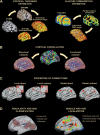Predictors of coupling between structural and functional cortical networks in normal aging
- PMID: 24027166
- PMCID: PMC6869592
- DOI: 10.1002/hbm.22362
Predictors of coupling between structural and functional cortical networks in normal aging
Abstract
Understanding how the mammalian neocortex creates cognition largely depends on knowledge about large-scale cortical organization. Accumulated evidence has illuminated cortical substrates of cognition across the lifespan, but how topological properties of cortical networks support structure-function relationships in normal aging remains an open question. Here we investigate the role of connections (i.e., short/long and direct/indirect) and node properties (i.e., centrality and modularity) in predicting functional-structural connectivity coupling in healthy elderly subjects. Connectivity networks were derived from correlations of cortical thickness and cortical glucose consumption in resting state. Local-direct connections (i.e., nodes separated by less than 30 mm) and node modularity (i.e., a set of nodes highly interconnected within a topological community and sparsely interconnected with nodes from other modules) in the functional network were identified as the main determinants of coupling between cortical networks, suggesting that the structural network in aging is mainly constrained by functional topological properties involved in the segregation of information, likely due to aging-related deficits in functional integration. This hypothesis is supported by an enhanced connectivity between cortical regions of different resting-state networks involved in sensorimotor and memory functions in detrimental to associations between fronto-parietal regions supporting executive processes. Taken collectively, these findings open new avenues to identify aging-related failures in the anatomo-functional organization of the neocortical mantle, and might contribute to early detection of prevalent neurodegenerative conditions occurring in the late life.
Keywords: FDG-PET; aging; cortical thickness; functional connectivity; functional-structural coupling; large-scale cortical networks; structural connectivity.
Copyright © 2013 Wiley Periodicals, Inc.
Figures






Similar articles
-
Age-related alterations in the modular organization of structural cortical network by using cortical thickness from MRI.Neuroimage. 2011 May 1;56(1):235-45. doi: 10.1016/j.neuroimage.2011.01.010. Epub 2011 Jan 14. Neuroimage. 2011. PMID: 21238595
-
Cortico-striatal connectivity and cognition in normal aging: a combined DTI and resting state fMRI study.Neuroimage. 2011 Mar 1;55(1):24-31. doi: 10.1016/j.neuroimage.2010.11.016. Epub 2010 Nov 10. Neuroimage. 2011. PMID: 21073962
-
Aging and large-scale functional networks: white matter integrity, gray matter volume, and functional connectivity in the resting state.Neuroscience. 2015 Apr 2;290:369-78. doi: 10.1016/j.neuroscience.2015.01.049. Epub 2015 Jan 31. Neuroscience. 2015. PMID: 25644420
-
Healthy aging by staying selectively connected: a mini-review.Gerontology. 2014;60(1):3-9. doi: 10.1159/000354376. Epub 2013 Sep 28. Gerontology. 2014. PMID: 24080587 Review.
-
Understanding cognitive control in aging: A brain network perspective.Front Aging Neurosci. 2022 Oct 31;14:1038756. doi: 10.3389/fnagi.2022.1038756. eCollection 2022. Front Aging Neurosci. 2022. PMID: 36389081 Free PMC article. Review.
Cited by
-
Structural architecture supports functional organization in the human aging brain at a regionwise and network level.Hum Brain Mapp. 2016 Jul;37(7):2645-61. doi: 10.1002/hbm.23200. Epub 2016 Apr 4. Hum Brain Mapp. 2016. PMID: 27041212 Free PMC article.
-
Network segregation is associated with processing speed in the cognitively healthy oldest-old.Elife. 2025 Mar 26;14:e78076. doi: 10.7554/eLife.78076. Elife. 2025. PMID: 40137179 Free PMC article.
-
Age-related structural and functional variations in 5,967 individuals across the adult lifespan.Hum Brain Mapp. 2020 May;41(7):1725-1737. doi: 10.1002/hbm.24905. Epub 2019 Dec 26. Hum Brain Mapp. 2020. PMID: 31876339 Free PMC article.
-
Using graph theory as a common language to combine neural structure and function in models of healthy cognitive performance.Hum Brain Mapp. 2023 Jun 1;44(8):3007-3022. doi: 10.1002/hbm.26258. Epub 2023 Mar 7. Hum Brain Mapp. 2023. PMID: 36880608 Free PMC article.
-
"Touching" the brain: braille reading mitigates the SC-FC decoupling of brain networks in congenital blindness.Brain Struct Funct. 2025 Jul 7;230(6):114. doi: 10.1007/s00429-025-02975-9. Brain Struct Funct. 2025. PMID: 40622597
References
-
- Batouli AH, Boroomand A, Fakhri M, Sikaroodi H, Oghabian MA, Firouznia K (2009): The effect of aging on resting‐ state brain function: an fMRI study. Iran J Radiol 6:153–158.
-
- Bernhardt BC, Chen Z, He Y, Evans AC, Bernasconi N (2011): Graph‐theoretical analysis reveals disrupted small‐world organization of cortical thickness correlation networks in temporal lobe epilepsy. Cereb Cortex 21:2147–2157. - PubMed
-
- Blumenfeld H, McNally KA, Vanderhill SD, Paige AL, Chung R, Davis K, Norden AD, Stokking R, Studholme C, Novotny EJ Jr, Zubal IG, Spencer SS (2004): Positive and negative network correlations in temporal lobe epilepsy. Cereb Cortex 14:892–902. - PubMed
Publication types
MeSH terms
Substances
LinkOut - more resources
Full Text Sources
Other Literature Sources
Medical

